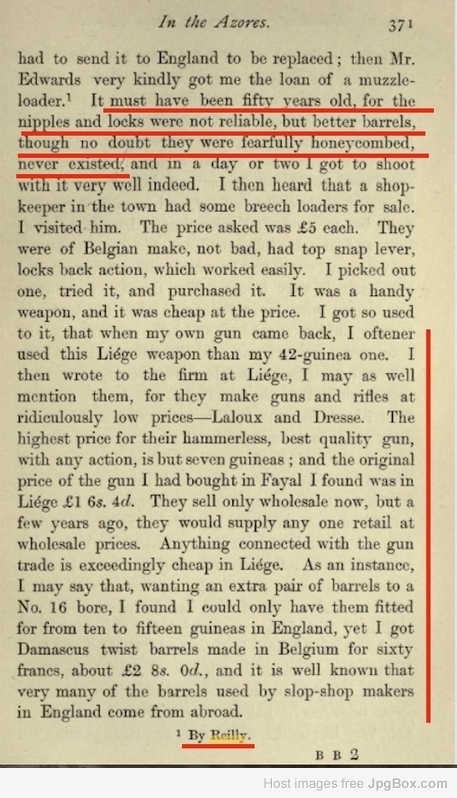Interesting Gene.
These damascus patterns were illustrated in the 1956 "Shooters Bible", probably from an early 1900s sales brochure by Marshall's of Birmingham..."genuine English Damascus produced in Marshall's workshops..."

This demonstration rod is from Midlands Gun Co., which was still offering Damascus barrels in their 1937 catalog; likely using up old stock. The Demon Hammer gun was £8 10shillings with steel barrels and £11 with damascus. The Perfection hammer gun was £10 10 shillings in steel and £12 10 shillings with damascus. Courtesy of Michael Baines.

The Modern Sportsman's Gun and Rifle: Including Game and Wildfowl Guns, Sporting and Match Rifles, and Revolvers
John Henry Walsh (Editor of The Field)
1882 http://books.google.com/books?id=OLwUAAAAYAAJI am indebted to Mr. Thos. Webley, who visited Belgium after the 1879 Trials, with a view to discover the reasons why the barrels forged there are more free from flaws than those made at Birmingham.
“A large quantity of Belgian tubes, called Pointille, similar in figure to our Iron Damascus (often called Laminated) have been used in cheap guns for the last three years, and these are especially wanting in toughness and density of metal. These tubes are cheaper than iron Damascus made at Birmingham, are more regular in figure, and have fewer greys, but the result is obtained at the entire sacrifice of density and toughness of metal; for it is a fact that, though these tubes may stand proof, the iron is so soft and rotten that they will not wear or stand any extra or repeated strain. These remarks apply, but in a smaller degree, to all Belgian tubes, whether Iron Damascus (Pointille/Twist), or Damascus (Damas turc). As one proof of this, when you see a choke-bored barrel bulge at the choke, it is almost sure to be a Belgian tube. We were, in common with our competitors, excepting for first and second quality, using a large proportion of these tubes; in fact, we think that quite
three-fourths of the tubes used in Birmingham are Belgian make, and nearly all the London trade use them, with this difference, that they use the best quality, which are no doubt harder than the cheaper kinds, but are still softer and less durable than those of English make, and cost as much.
On remarking to some of the Liege makers that their barrels were sure to be soft made on their principle, and that that was the great objection we had to Liege tubes, their reply was that they only studied three things: First, to get the greatest possible distinction in colour (black and white when browned) between their iron and steel; secondly, regularity of figure; thirdly, clearness of iron; and that whether they were hard or soft was of no consequence to them.”
P. Webley And Sons.
K. Paul Trench was unimpressed with the Belgian product; in "Practical Hints on Shooting",
1887 "Belgian Damascus is a wretched apology for that of English make, and we caution the reader to eschew guns with barrels of this description. For elegance and outward appearance it would be difficult to excel the former, but when it comes to actual use they are worthless trash. At first, perhaps, they shoot very well; but wait a little while, and see how long they will retain their shooting powers. As for choking them, it is next to useless, as the chances are five to one that they will bulge after a little use. A very small percentage of steel is employed in their manufacture; hence the metal is of a soft and fragile texture."
c. 1890 James Purdey II wrote concerning steel barrels that he preferred damascus but acknowledged that "...weight for weight steel is stronger than iron and shoots harder, though not of so handsome an appearance as damascus barrels." He favored Belgian damascus because "...not that when thorough sound English damascus can be obtained they are not superior, but because Belgian workmen are more careful than English, and there is thus less risk of slag and rubbish getting into the welds."








